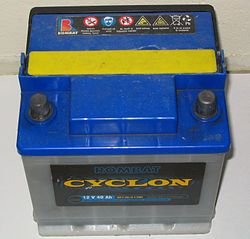Intoxication by lead and its compounds
In practice, 'intoxication with an inorganic or organic form of lead is possible. Inorganic intoxication is much more common, most often in the work environment.
Intoxication with an inorganic form of lead[edit | edit source]
Lead is a dull gray, heavy, malleable metal (Saturn metal), it dissolves well in gastric juice, its inorganic salts are relatively poorly soluble in water, but the soluble (and therefore more toxic) include oxides, acetate and nitrate.
Professional exposure[edit | edit source]
- Production and repairs of car batteries,
- ""casting in smelters"" (production of lead, bronze, brass),
- during 'soldering (lead-tin alloy),
- production of lead glass, cartridges, glazes (PbO) and pigments (surinite, Pb3O4),
- rarely from lead glazes on ceramic dishes (hot tea with lemon - releases lead), or swallowing devils (ammunition).
Etiopathogenesis[edit | edit source]
Lead is absorbed either by respiration or from the GIT;
- respiratory in the form of vapor and dust (absorbed from about 40%),
- from the GIT is absorbed by about 8%, it is better absorbed if it stays longer in the stomach, in children it is absorbed by up to 50%.
Higher absorption of lead occurs with calcium and iron deficiency and during starvation. Pb2+ ions have two main properties, affinity to SH groups and substitution of Ca2+ ions. After absorption, lead binds to hemoglobin, distributes throughout the body and deposits in the bones, brain'' (mainly in children), kidneys, "liver", muscles, skin (and adnexa). The largest proportion of lead is deposited in the bones, where it replaces calcium (in practice, this causes a higher bone contrast on X-ray), from where the lead can be released back into the circulation during fever or pH changes. Lead is excreted in 80% of the urine, the half-life of lead in the blood is 30 days. It is excreted from the bones for 5-10 years.
Free lead in the body inhibits the enzymes involved in the synthesis of hemeu':
- 5-ALA dehydrogenase' - ALA accumulates,
- coproporphyrin oxidase - coproporphyrin accumulates,
- hemesynthetase - protoporphyrin and iron accumulate, resulting in normocytic normochromic anemia, an increase in serum iron.
Clinical picture[edit | edit source]
Manifestations of 'acute lead poisoning:
- after ingestion, symptoms of GIT irritation dominate – vomiting, diarrhea,
- colic pains.
Manifestations of chronic lead intoxication:
- gradual development of anemia' - fatigue, exertional dyspnea, apathy, muscle and joint pain,
- gray border on the gums, constipation, saturnine colic (diffuse colic pain in the abdomen) that does not respond well to antispasmodics,
- in more severe intoxications liver enzymes and bilirubin may be increased (Pb is deposited in the liver),
- nephropathy with damage to the proximal tubules occurs rarely (Fanconi syndrome with aminoaciduria, glycosuria and phosphaturia),
- very rarely – saturnine gout, hypertension, neuropathy (the radial nerve is most often damaged).
Investigative methods[edit | edit source]
- Laboratory blood test - lead level in the blood - plumbemia - correlates with the clinical picture of poisoning, permissible limit for workers - 0.4 mg/l, levels up to 0 are common in the population, 1 mg/l,
- blood picture - anemia (normochromic, normocytic), basophilic staining in erythrocytes is typical, erythrocytes are fragile,
- laboratory examination of urine':
- 5-ALA and coproporphyrin III in urine – signs of recent lead exposure,
- monitoring of lead in urine - serves to determine the depot (excretion of more than 2 mg/day means a large amount of Pb in the body).
Thanks to laboratory tests, differential diagnosis is relatively easy, the most important thing is to think about the possibility of lead intoxication. Otherwise, lead poisoning can be confused with anemia of unclear etiology (in case of chronic) or NPB (in case of acute poisoning).
Therapy[edit | edit source]
The treatment is carried out with chelating substances - they chelate lead ions, the chelates are excreted in the urine:
- EDTA - a classic drug, applied in a slow infusion (it is slightly nephrotoxic, so 500 ml of physiological solution or 5% glucose is given with it),
- DMSA - dimercaptosuccinic acid, applied in tablets, preferred especially for children.
Professionalism Assessment[edit | edit source]
- NzP threat - increase in BET above limits without symptoms,
- announcement of intoxication (i.e. NzP) - when anemia or other damage is detected,
- sometimes it is necessary to distinguish between intentional ingestion and the intention to emphasize professional poisoning.
Intoxication with an organic form of lead[edit | edit source]
This form of intoxication is no longer of such importance today, previously mainly "tetraethylol" (anti-knock additive to gasoline). Tetraethylol is a fat-soluble substance, which is why it is ``neurotoxic.
- Toxic psychosis is typical - headaches, sleep disturbances, dizziness, blurred vision, auditory hallucinations, later convulsions and coma. Anemia does not occur here.
- The examination of plumbemia, which is only slightly increased, is usually not enough, the diagnosis is confirmed only by the examination of urine, which reveals plumburia.
- DMSA is recommended for 'therapy, EDTA is ineffective.
Links[edit | edit source]
Related Articles[edit | edit source]
Source[edit | edit source]
- BENEŠ, Jiří. Studijní materiály [online]. [cit. 24.02.2010]. <http://jirben.wz.cz>
References[edit | edit source]
- PELCLOVÁ, Daniela. Occupational diseases and intoxication. 2. edition. Karolinum, 2006. 207 pp. ISBN 80-246-1183-X.




